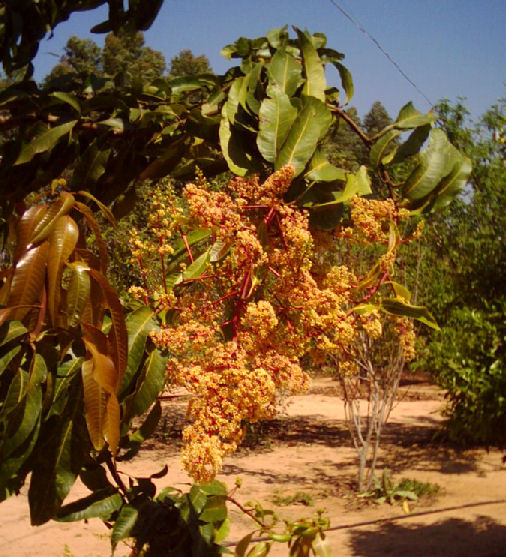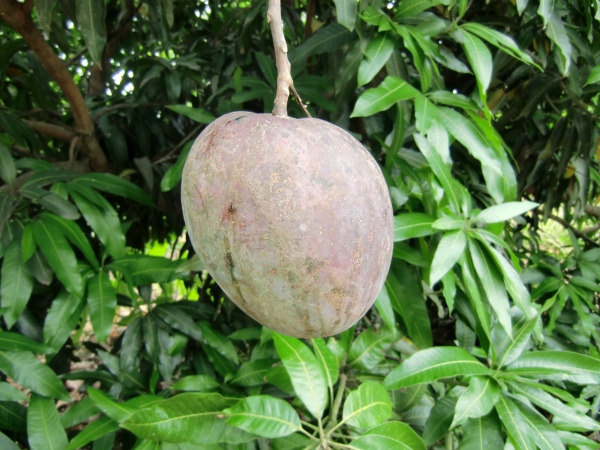

Mangos
We have 12 mango trees of different cultivars, two of them are from the cultivar Mangifera indica 'Tommy Atkins' in our yard.
Mangifera indica originates from India and is in the tropical rainforest at home, today it occurs as cultural plant worldwide, where the climate is tropical and frostfree, is not hardy in Germany, Austria and the Switzerland. India still is considered as a main producer of mango fruits in all over the world, with one production of 9.5 millions tons. In Europe mango trees are cultivated only in the frostfree climate in Southern Spain (Costa del Sol) and on the Canary Islands.
The tree is evergreen and can grow to 150 feet (45 meters) tall and reach one crown diameter to 33 feet (10 meters), but there are cultivars which are staying smaller. The new growth is at first salmon colored and becomes slowly darkgreen. The small white to pink flowers are standing in the erect trusses. They are sweet with lilies. After the flowers faded in August and September, they ripe from December to March in Southern Brazil in varying of cultivars.
The ripen fruit is hanging at long stalks and weights to 2 kg, it has one thin and smooth skin, below it varying in the degree of ripening soft to fibrous pulp, which is enclosed one large and oblate pit. The coloration oft he fruit reachs from green over yellow to red, often one combination of all three colors will occur. The peeled fruit has a strong aromatic-sweetish fragance and peech-like taste, in Brazil the fruits are tasting much intensiveer, sweeter and aromatic. The in the German supermarkets offered fruits are tasting fade and turpentinish, because the fruits are harvested still unripen from the trees in Brazil and transported by refrigerated ships to Germany like bananas and have to after-ripen in the supermarkets, the aroma is losing there.
There are about 1,000 mango cultivars worldwide, which are differing in the form, size and taste, in Brazil alone there might be about 20 mango varieties. The fruits are used for juice, jam, compote and ice cream. The fruit is only ripen alright when it is fragant and soft. Fully ripen mangos do have small to medium sized black spots.
'Tommy Atkins'
This is
one cultivar, which is bred for the commercial export and is also
commercially grown in Brazil and is exported from there to Germany. The
fruit has a regularly oval form, medium sized to large, weights between 12
and 24 ounces, yellowish orange with deep red to purpurish spots, thicker
skin, juicy but firm with medium part of fiber.
This selection is developed in around of 1920 in Fort Lauderdale in
Florida/U. S. A. We had bought two very beautiful specimens with our mansion
and yard.

One of the both mango trees of the cultivar 'Tommy Atkins' in our yard late January 2008.

Mango flowers in September 2008 in our yard.

Halfripen mango fruit at the tree in December 2009.
Updated by Joachim Jaeck on October 14th, 2013